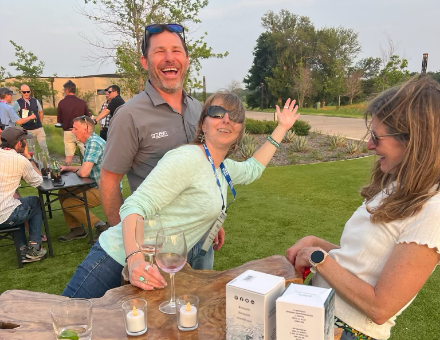SAM Magazine—Frisco, Texas, May 31, 2024—The 2024 National Ski Areas Association (NSAA) National Convention and Tradeshow welcomed 687 attendees to the Omni PGA Frisco Resort, May 21-24, for meetings, educational sessions, tradeshow, and networking. 
Many of the industry’s biggest challenges and opportunities were discussed, both formally and informally, and the event wasn’t short on surprises.
Starting with Wednesday’s opening general session, NSAA president and CEO Kelly Pawlak revealed that preliminary results show United States ski areas saw roughly 60.4 million skier visits during the 2023-24 winter season—the fifth highest total since NSAA began tracking skier visits in 1978-79.
This came as a surprise to many in attendance considering the roller-coaster season that most ski areas endured from coast to coast. However, it speaks to the ongoing demand for skiing and riding as well as the outsized percentage of visitation that extra-large ski areas see (54 percent of the total visits).
A couple other surprises came at the final general session on Thursday morning.
Following keynotes from PGA of America’s Dawes Marlatt and Paralympian Patrick Halgren, Pawlak shared that attendees had so far donated $15,500 to the Mountain Foundation—a fund that provides scholarships for industry personnel to attend educational events—nearing the goal of $25,000, which former Alterra CEO Rusty Gregory would match. Her plea to continue donating was answered by Leitner-Poma of America president Daren Cole, who said, “We’ll take care of that for you,” and pledged $20,000 to the foundation.
Pawlak then introduced newly appointed NSAA board chair Chip Seamans, who delivered the news that Pawlak was stepping down as president and CEO after seven years in the role. Seamans thanked Pawlak for all she’s done, and the hundreds of attendees in the room responded with a long standing ovation.
Unsurprisingly, a common thread throughout the event was the U.S. ski industry’s collaborative culture, where competitors are also resources for one another. Lifetime Achievement Award honoree Kenny Hess (Massanutten, Va.) talked about “the unique tribe of our industry” and how we’re all willing to help each other, but warned there are risks to that culture as companies continue getting bigger and thus can rely on internal resources rather than external. He encouraged everyone to continue collaborating despite ongoing consolidation.
Educational sessions laid bare the existing spirit of collaboration. Panels comprised of leaders from different ski areas and ownership companies shared useful insights on topics like growth, parking and transportation, the political landscape, and capacity. Other sessions were led by subject-matter experts who dove into topics such as weather forecasting, inclusivity, crisis communications, and climate change.
Of course, the sessions were designed to address many of the industry’s greatest challenges and opportunities. The keynote speakers discussed these topics, too.
Wednesday’s keynote Alexander Benjamin, Jamaica’s first Olympic downhill skier, talked about how complicated it is to participate in skiing and riding. Benjamin didn’t get into the sport until he was 32 years old and discovered first-hand the difficulties of navigating a resort from parking lot to lift, finding the right equipment, and, as a Black man, not seeing people who look like him represented in ski area marketing until recently.
“Our obvious is not their obvious,” he said of the experience many new participants have because they don’t know what they don’t know yet. This is especially true for youth who don’t come from skiing families and aren’t exposed to the experience at a young age.
Related to this point, NSAA’s Growth Committee has determined that the industry should target people under the age of 25 in an effort to future-proof participation, as presented in a session called “Broadening Horizons: Ski Area Strategies for Inclusive Growth.” Participation by this younger demographic has consistently shrunk since 2010-11, according to the NSAA annual demographic study. And the preliminary results from the Kottke report show lesson visits in 2023-24 declined 14 percent year-over-year, which is a concern that the committee is encouraging ski areas to address.
Despite a shrinking number of younger participants and fewer lessons being taken, the industry continues to enjoy strong visitation as older generations are skiing more often.
This visitation is translating to strong revenue, which ski areas are spending on capital projects. In a session led by data research firm RRC Associates, which conducts the annual Kottke report, economic analysis and demographic studies, U.S. ski areas invested $754.3 million in capital expenditures in 2023-24. Lifts were the biggest investment category ($293 million), followed by other on-mountain facilities ($176 million) and, notably, workforce housing ($113.6 million). Responding ski areas are projecting $457 million in capital expenditures for 2024-25.
On the social side, the tradeshow receptions were abuzz as operators and suppliers mingled, discussing the latest and greatest products and services. Several suppliers SAM spoke to said they came away with excellent leads for potential new business, which, of course, is the goal.
The 2025 NSAA National Convention and Tradeshow is scheduled for May 11-14, in Marco Island, Fla.














































